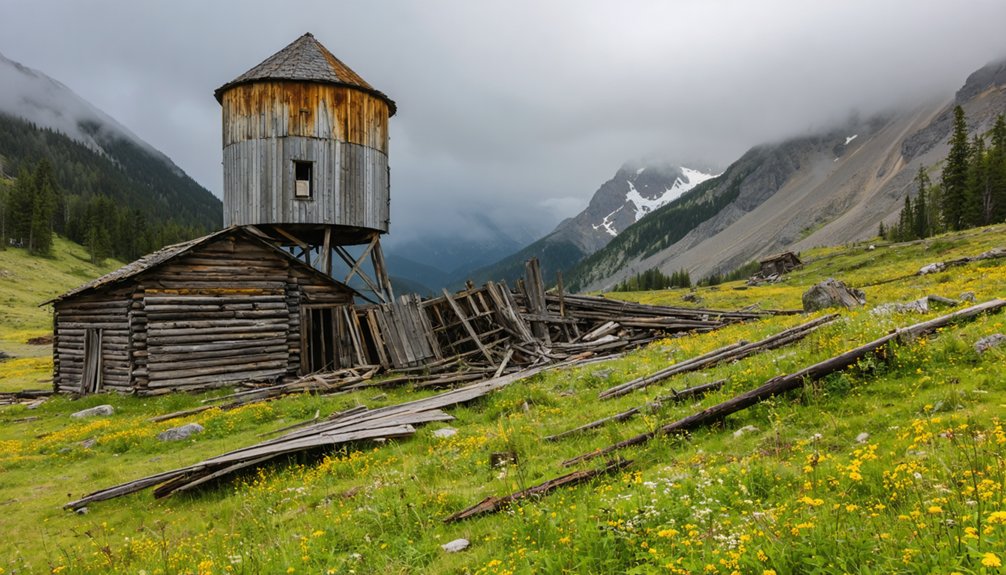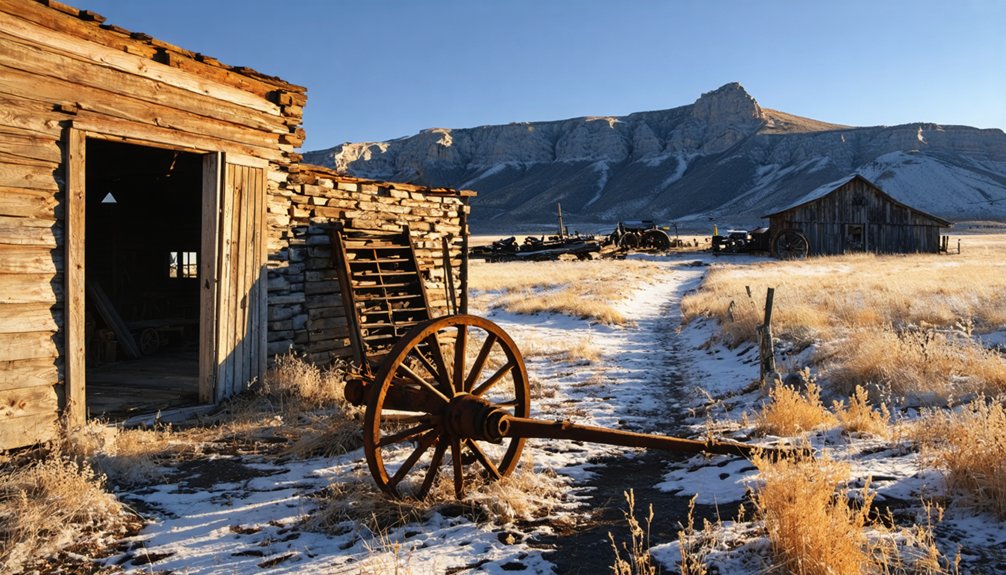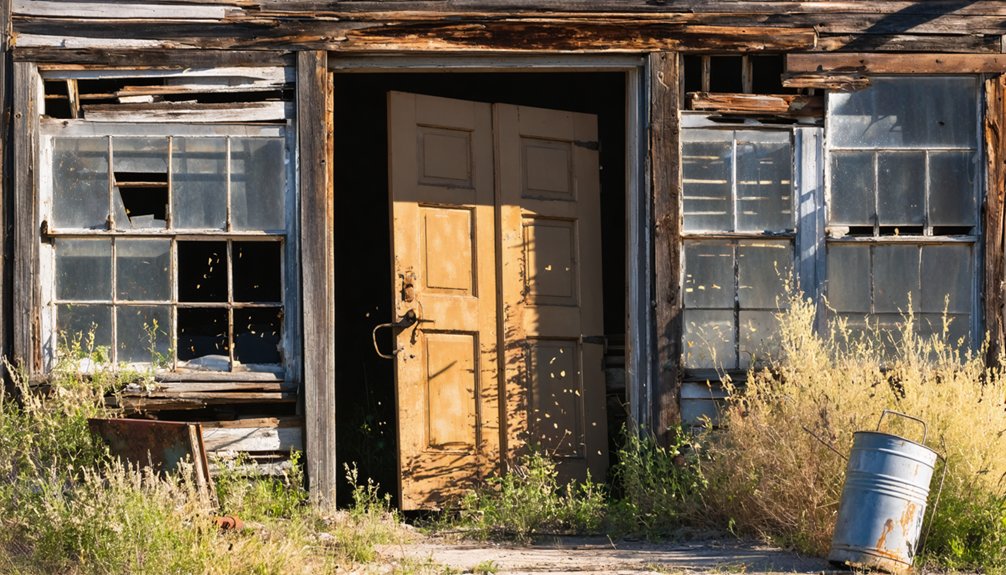You’ll discover Fairmount as one of Colorado’s earliest gold rush settlements, established in 1858 as Arapahoe City. Initially thriving under leaders Marshal Cook and Thomas Golden, it briefly served as Jefferson County’s first seat in 1859. The settlement declined as neighboring Golden prospered, shifting from mining to agriculture before fading into obscurity by the early 1900s. Historical markers near 44th Avenue and McIntyre Boulevard preserve this forgotten chapter of pioneer ambition.
Key Takeaways
- Founded in 1858 as Arapahoe City during Colorado’s gold rush, Fairmount declined when nearby Golden prospered.
- Served as Jefferson County’s first seat in 1859 before fading into historical obscurity.
- Mining operations ceased by early 1900s, forcing residents to switch to agriculture despite harsh climate conditions.
- The Fairmount Gold and Silver Mining Company led extraction efforts during the settlement’s brief mining boom.
- Historical markers at 39°46′30″N 105°10′42″W commemorate the ghost town’s mining heritage and indigenous connections.
The Rise and Fall of Arapahoe City (1858-1863)
Though largely forgotten today, Arapahoe City emerged as one of Colorado’s earliest gold rush settlements when the Arapahoe Town Company formally established it on November 28-29, 1858.
Named after the Arapaho tribe, this placer mining community quickly attracted gold seekers to Clear Creek, where the Estes Party had discovered deposits in 1834.
Under the leadership of Marshal Cook and Thomas Golden, the settlement grew rapidly but eventually declined as neighboring Golden prospered. The town’s name reflected the historic presence of Native Americans who had inhabited the plains of Colorado and Wyoming long before settlers arrived.
From Mining Hub to Agricultural Community
You’ll find Fairmount’s origins in the mid-19th century gold rush when prospectors established the settlement along Clear Creek to extract the area’s mineral wealth.
As ore quality declined and veins exhausted by the turn of the century, mining operations gradually shut down, forcing the remaining population to seek alternative livelihoods. Fairmount followed the typical pattern of mining towns that began with temporary structures and evolved based on resource availability.
The community’s shift to agriculture represented a survival strategy, with former mining lands repurposed for crops and livestock, though the harsh Rocky Mountain climate and poor soil ultimately limited its agricultural potential. Similar to St. Elmo’s decline, Fairmount’s population dwindled after mining operations ceased in the early 1900s.
Gold Rush Origins
While the discovery of gold in Colorado didn’t begin directly in Fairmount, the 1858 findings by William “Green” Russell’s party at Little Dry Creek set in motion a chain of events that would shape the region’s future.
Eastern newspapers quickly spread the news, triggering the massive Pikes Peak Gold Rush of 1859 that brought over 100,000 prospectors seeking fortune.
John Gregory’s discovery in what became Central City created “The Richest Square Mile on Earth,” while Russell established the less wealthy but long-productive Russell Gulch nearby.
These gold discoveries birthed numerous settlements including Denver, Boulder, and Breckenridge.
Various mining techniques evolved as prospectors extracted placer gold from streams before developing more sophisticated lode mining operations.
The transition to lode mining became essential as placer deposits exhausted quickly in the harsh Colorado terrain, leading to a brief depression in the mining industry.
This second-largest mining excitement in American history would eventually influence Fairmount’s creation and ultimate transformation. As mining activities expanded, the Argo Tunnel was completed in 1910 to provide drainage and transportation routes for ore extraction.
Clear Creek Mining
Clear Creek emerged as a focal point of Colorado’s mining evolution following the initial gold rush excitement.
As prospectors depleted placer gold deposits, attention shifted to industrial minerals including coal, clay, and aggregates that provided sustainable economic opportunities. The area’s abundant water resources and rail access supported this diversification into smelting, brewing, and brickmaking industries.
Mining governance evolved from informal claim protection to structured district laws. Communities established local officials and formal governance structures as the territorial Legislature subdivided the region into counties.
This administrative evolution helped maintain order during the shift from gold extraction to broader industrial development.
The landscape transformed dramatically through excavation and subsequent reclamation efforts, reflecting changing attitudes toward land management.
These modifications eventually set the stage for Fairmount’s change from mining hub to agricultural community.
The Colorado School of Mines was established as a legacy of mining that contributed to the region’s technical advancement.
The expansion of prospecting westward along Clear Creek led to the discovery of new mineral deposits that sustained the region’s economic viability.
Agriculture Replaces Mining
As mining operations dwindled throughout the Clear Creek region in the late 19th century, Fairmount underwent a remarkable economic change that would define its future identity.
You’d have witnessed former miners shifting to farming, converting abandoned mining lands into productive agricultural fields. This shift wasn’t merely circumstantial but strategic, offering sustainable economic stability beyond mining’s boom-and-bust cycle. This transformation mirrors modern examples like Michael Lobato who transitioned from mining to agriculture despite initial community skepticism. The transition faced increasing challenges as extreme weather events became more frequent, similar to the hail storms and droughts affecting Colorado’s farms today.
- Local farmers implemented irrigation innovations, diverting Clear Creek water to nurture wheat and barley fields.
- Former mining infrastructure found new purpose as agricultural storage and processing facilities.
- Native livestock breeds thrived on converted pastureland, providing economic diversification.
- Fruit orchards flourished in the region’s microclimate, becoming signature local products.
- Sustainable practices like crop rotation emerged, preserving soil health for future generations.
Life Along Clear Creek: Daily Existence in Early Fairmount
When Fairmount emerged along the banks of Clear Creek in 1886, it developed not as a booming mining town but as a modest agricultural settlement where daily existence revolved around the rhythms of rural life.
You’d start your day tending livestock and crops, relying on Clear Creek’s waters for irrigation in the challenging Colorado climate.
Your daily routines would be punctuated by seasonal work—planting, harvesting, and preserving food for winter months.
The rhythms of the seasons dictated your labor—sowing in spring, tending in summer, and preserving autumn’s bounty for winter’s scarcity.
Community gatherings provided essential social connections in this isolated environment. You’d join neighbors for church services, school events, and seasonal celebrations that strengthened community bonds.
With limited access to outside resources, you’d depend on local general stores and barter systems for necessities.
During harsh winters, you’d find yourself largely cut off, relying on preparations made during warmer months.
The Wannemaker Legacy and Early Settlement

The Wannemacher family story intertwines with Fairmount’s early development, though in ways less direct than other pioneer families along Clear Creek.
While the famous John Wanamaker built his retail empire in Philadelphia, distant relatives with the Wannemacher surname (later anglicized to Wanamaker) likely settled in Jefferson County during the mid-19th century westward migration.
Their journey represents the quintessential American pursuit of opportunity that shaped Colorado’s frontier communities.
- Originally German-speaking immigrants seeking economic advancement
- Family members typically engaged in brickmaking, farming, and trades
- Settlement patterns followed mining and agricultural development in the 1860s-70s
- Wanamaker influence appeared through community-building and local enterprises
- Legacy impact remains visible in early structures and economic foundations
You’ll find their contributions embedded in the fabric of Fairmount’s earliest community structures, reflecting the determination that characterized Colorado’s pioneer spirit.
Gold Mining Operations and Economic Development
Gold fever transformed Fairmount’s landscape during the Colorado gold rush, establishing it as a vibrant mining camp where fortune-seekers converged in the pursuit of mineral wealth.
You’d have witnessed the evolution of mining techniques from simple placer operations—using pans and sluices in streambeds—to complex lode mining with deep shafts extracting gold from veins embedded in rock.
The Fairmount Gold and Silver Mining Company led organized extraction efforts along the Colorado Mineral Belt, replacing individual prospectors. This mining boom triggered rapid population growth and infrastructure development.
However, the town’s prosperity remained vulnerable to economic fluctuations, with gold price volatility and ore depletion threatening stability.
What Remains: Monuments and Historical Markers

You’ll find the original dedication plaque installed in 1923 at the southeast corner of Fairmount’s former town center, marking where the bustling mining community once stood before its abandonment in the late 1890s.
The granite monument, erected by the Colorado Historical Society, includes detailed inscriptions of the town’s founding date, prominent mine owners, and references to the devastating 1896 fire that accelerated the town’s decline.
Recent preservation efforts by the Arapahoe County Historical Commission have restored the weathered markers and added interpretive signage that chronicles the indigenous Arapaho presence in the region before gold was discovered.
Dedication Plaque History
While commemorating the rich mining heritage of Colorado’s Front Range, the dedication plaque installed in 1946 stands as the most significant physical remnant of Arapahoe City, Jefferson County’s pioneering settlement.
This stone marker honors the town founded on November 28, 1858, acknowledging its dedication significance as a tribute to the Arapahoe tribe and the area’s evolution from mining to agriculture.
The plaque materials were selected for durability, ensuring this historical record would endure despite the ghost town’s disappearance by the 1890s.
- Represents the only tangible evidence of Arapahoe City’s existence
- Preserves the memory of Jefferson County’s first city
- Connects the historical lineage between mining camps and Fairmount Cemetery
- Symbolizes respect for both Native American heritage and pioneer settlers
- Serves as an educational landmark for visitors seeking frontier history
Monument Location Details
Three distinct monument locations preserve the memory of Fairmount’s mining history, each offering visitors a tangible connection to Colorado’s frontier past. The primary marker stands on 44th Avenue’s south side, approximately 1,000 feet west of McIntyre Boulevard at coordinates 39°46′30″N 105°10′42″W, elevation ~5,585 ft, indicating the ghost town’s original site.
Throughout the area, state and county-installed plaques highlight Fairmount’s historical significance, though no original structures remain.
The monument significance extends beyond physical remnants to tell the story of Colorado’s development during the mining boom. Despite limited physical evidence, marker preservation efforts guarantee these memorials remain in good condition, allowing you to experience this freedom-seeking community’s legacy while standing where pioneers once built their dreams.
Preserving Arapahoe’s Memory
Although the original town of Arapahoe has vanished from the Colorado landscape, a single historical marker stands as its enduring legacy on the south side of 44th Avenue between Golden and Wheat Ridge.
Located approximately 1,000 feet west of McIntyre Boulevard, this marker preserves Arapahoe’s historical significance as one of Colorado’s earliest settlements, founded November 29, 1858.
- The marker sits at coordinates 39°46′30″N 105°10′42″W at 5,585 feet elevation
- It commemorates Arapahoe’s role in Colorado’s gold rush history
- Local foundations like Fairmount Heritage Foundation help maintain this historical record
- The site represents Colorado’s pioneer heritage despite having no remaining structures
- Educational signage contextualizes Arapahoe’s place in the broader settlement patterns of early Colorado
Fairmount’s Place in Jefferson County History

Established as one of Jefferson County’s earliest settlements, Arapahoe City emerged on November 28, 1858, marking the beginning of organized European-American presence in what would later become Fairmount.
This pioneering community served as Jefferson County’s first seat when the county formed under the provisional Jefferson Territory in 1859, highlighting its significant administrative role.
You’ll find Fairmount’s Arapahoe Heritage embedded in the region’s political foundations, with the town hosting early government functions and supporting critical infrastructure like the post office established in January 1860.
Though the settlement’s prominence faded as Golden rose to dominance, Fairmount’s evolution from mining camp to agricultural community exemplifies the dynamic transformation of Colorado’s frontier settlements.
Historic Preservation efforts, including the 1946 monument, guarantee this pivotal chapter in Jefferson County’s formation isn’t forgotten.
Frequently Asked Questions
Why Was the Name Changed From Arapahoe City to Fairmount?
You’ll find the name’s origin shifted as Arapahoe City’s historical significance waned. After mining declined in the 1860s, agricultural development transformed the area, necessitating a fresh identity—Fairmount—reflecting its new rural character.
Were Any Significant Artifacts Recovered From the Original Settlement?
Yes, you’ll find significant artifacts were recovered, including ceramics, glassware, and metal items. These 40 pieces enhance historical preservation efforts and demonstrate artifact significance in understanding daily life.
How Did Clear Creek Flooding Affect the Early Settlement?
Like a watery fist, Clear Creek’s recurring floods devastated your early community. You’d face settlement challenges including destroyed bridges, washed-out roads, altered landscapes, and economic setbacks from 1890 through the 1950s.
What Indigenous Tribes Inhabited the Area Before European Settlement?
Before European arrival, you’d find the Ute people were the primary indigenous inhabitants, with their Native Tribes’ presence spanning thousands of years. The Arapaho and Cheyenne also passed through, establishing Cultural Significance throughout the region.
Did Any Famous Colorado Historical Figures Visit Arapahoe City?
Pioneering prospectors like George Jackson and John Gregory visited Arapahoe City. You’ll find famous visitors like Thomas Golden, Marshall Cook, and Samuel Curtis were integral to the town’s historical significance during Colorado’s early days.
References
- https://www.goldenhistory.org/arapahoe-city-jefferson-countys-first-city/
- https://en.wikipedia.org/wiki/Arapahoe
- https://www.youtube.com/watch?v=dJh-hKmpD_Y
- https://www.ebay.com/itm/236078411466
- https://caturner.wordpress.com/2013/05/11/arapahoe-city-lonely-marker-all-thats-left-of-early-colorado-outpost/
- https://historicjeffco.wordpress.com/landmarks/monuments/arapahoe-city/
- https://cogenweb.org/arapahoe/history/sketch_arapahoe.html
- https://history.denverlibrary.org/sites/history/files/RealPioneersColorado.pdf
- https://historicjeffco.wordpress.com/2016/11/29/anniversary-of-arapahoe-city/
- https://www.familysearch.org/en/wiki/Arapahoe_County



